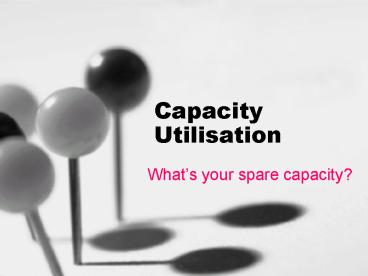Capacity Utilisation - PowerPoint PPT Presentation
1 / 12
Title:
Capacity Utilisation
Description:
What is the main difference between economies and diseconomies of scale? ... overcrowded, work may become less efficient due to the untidy working conditions ... – PowerPoint PPT presentation
Number of Views:732
Avg rating:3.0/5.0
Title: Capacity Utilisation
1
Capacity Utilisation
- Whats your spare capacity?
2
Recap economies of scale
- What is the main difference between economies and
diseconomies of scale? - What are the 5 main economies of scale?
- Why might employee motivation decrease as a
result of growth? - What are the managerial motives for growth?
3
Capacity Utilisation
- A firms productive capacity is the total level
of output or production that it could produce in
a given time period. - Capacity utilisation is the percentage of the
firms total possible production capacity that is
actually being used.
4
Another formula
- Capacity utilisation
- Current output x 100
- Maximum possible output
Company can make 10,000 units Are currently
making 7,000 Capacity at 70 with 30 spare
capacity (3,000 units!)
5
Capacity calculations
- Company has 50,000 capacity
- They made
- 45,000 this year
- 30,000 last year ..
- What would the cost per unit be if the FC were
2m?
2m/45,000 44.44 per unit 2m/30,000
66.67 per unit
6
So why dont all businesses work at 100
capacity..?????
- may not be enough time for routine maintenance,
so machine breakdowns may occur more frequently
and orders will be delayed
Staff may feel under excessive pressure, leading
to increased mistakes, absenteeism and labour
turnover
Youll have to spend more on staff overtime to
satisfy orders, increasing labour costs
Draw backs of 100 capacity.
- If the factory space is overcrowded, work may
become less efficient due to the untidy working
conditions
- It may not be possible to meet new or unexpected
orders so the business cannot grow without
expanding its scale of production
7
Whats wrong with working at 100 capacity?
Gym
hospitals
trains
8
What causes under utilisation?
- New competitors
- new products substituting yours
- Change in tastesfashion
- Unsuccessful marketing campaign
- Seasonal demand .crackers and flip flops!
- Over investment in new technology
- Merge between 2 businesses.
9
Whats the best capacity utilisation?
- something between 80 to 90 capacity utilisation
because fixed costs per unit are relatively low
and there is some scope to meet new orders or
carry out maintenance and training. - A firm that has just invested in major new
facilities in anticipation of major growth could
take some time before reaching a good level of
utilisation, so it is important to consider sales
trends when discussing capacity utilisation.
10
Problems arising from low capacity utilisation
- Higher fixed costs per unit mean reduced
profitability if prices were raised to cover
these costs, this would probably lead to reduced
sales unless the product was price inelastic. - Spare capacity can portray a negative image,
particularly in a business where it can be seen
that it is no longer busy such as a shop or a
health club - signifying loss of popularity - Staff can become bored and demoralised if they
dont have as much to do, especially if they fear
losing their jobs
11
How to improve capacity utilisation.?
- Increase demand.. But how???
- Cut capacity.But how???
- Lease or sell off part of production line
- Reduce hours.shorter working week or cut hours
per day - Lay off workers!
R A T I O N A L I S E
12
Opportunity cost
- What are the benefits of having spare capacity?
- Can meet sudden increase in demand
- Can allow staff time for training
- Machines can be fixed without disrupting
productivity.
- WORK TO DO
- P340 revision questions
- 2, 4, 5, 6
- Read unit 48
- Make notes on EVALUATION section.

